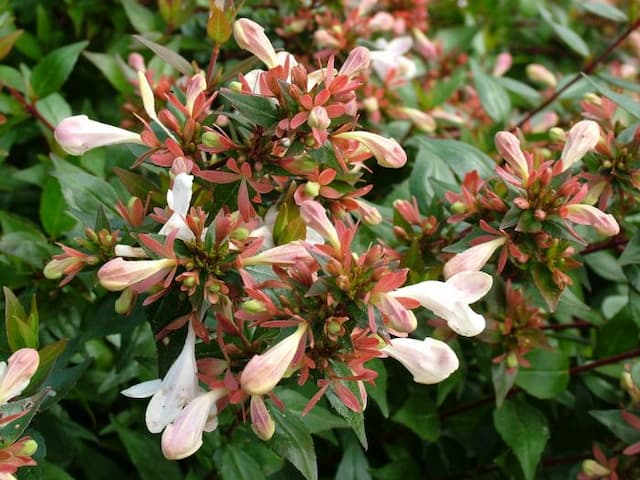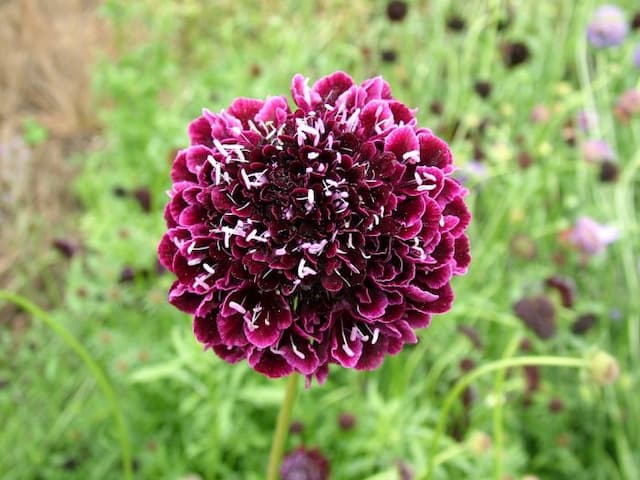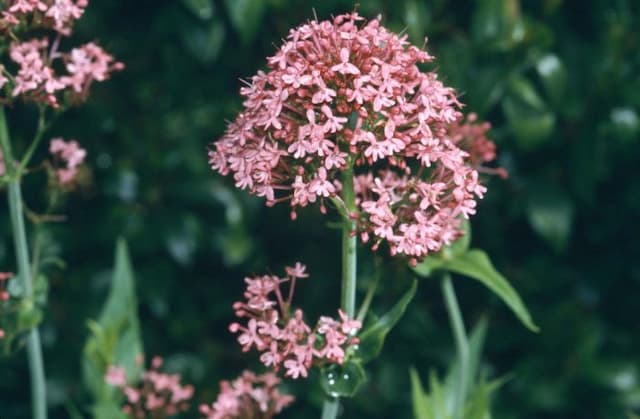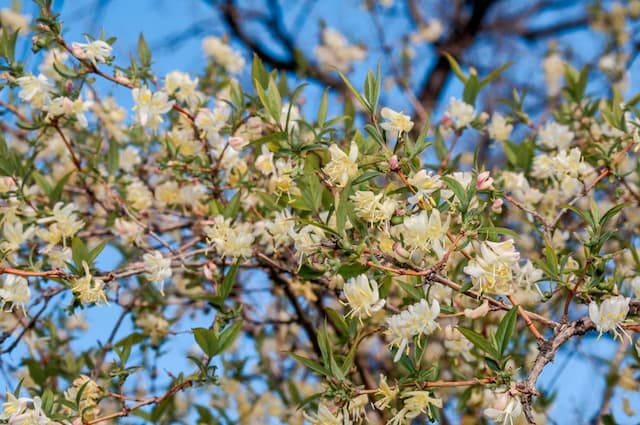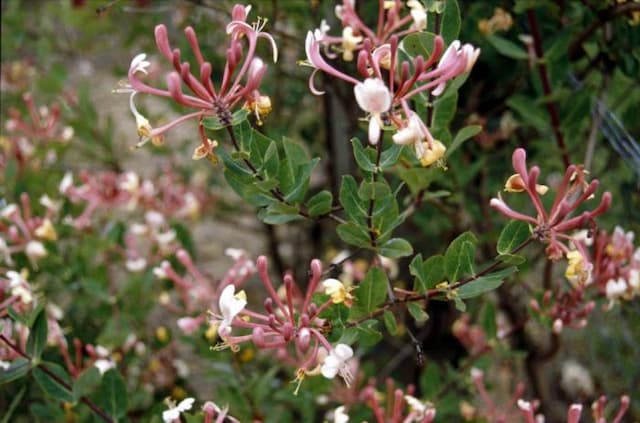Snowberry Symphoricarpos Magical Galaxy = 'Kolmgala' (PBR)

ABOUT
The Symphoricarpos Magical Galaxy, commonly known as Snowberry, is characterized by its enchanting visual appeal. This deciduous shrub features gracefully arching branches that are adorned with an abundance of small, lanceolate leaves. These leaves display a fresh green hue, providing a lush backdrop for the plant’s remarkable berries. As the Snowberry's name suggests, the most distinctive feature of this plant is its clusters of striking, pearly white berries that appear as the seasons turn from summer into fall. The berries are round and plump, nestled among the leaves, creating a charming contrast with their snowy color against the verdant foliage. During the blooming season, the Snowberry blossoms with small bell-shaped flowers. These flowers have a delicate pale pink or white color, adding a subtle touch of beauty before giving way to the more eye-catching berries. The visual dance of its simple flowers transitioning to its signature white berries makes the Snowberry Magical Galaxy a captivating sight in any garden landscape.
About this plant
 Names
NamesFamily
Caprifoliaceae
Synonyms
Magical Galaxy Snowberry, Kolmgala Snowberry
Common names
Symphoricarpos x doorenbosii 'Kolmgala' (PBR).
 Toxicity
ToxicityTo humans
The Symphoricarpos Magical Galaxy, commonly known as Snowberry, is considered to have a low level of toxicity to humans. If ingested, parts of the plant, particularly the berries, can cause mild symptoms of poisoning. These symptoms may include vomiting, dizziness, and nausea. In general, Snowberry is not considered highly poisonous, but eating its berries or any other part should be avoided to prevent these unpleasant symptoms and potential health concerns.
To pets
The Snowberry is also toxic to pets. If ingested by dogs, cats, or other animals, they might experience similar symptoms of poisoning as humans do. This can include vomiting, diarrhea, and in some cases, more severe symptoms such as seizures or difficulty breathing. It is important to prevent pets from eating any part of the Snowberry plant to avoid these possible consequences.
 Characteristics
CharacteristicsLife cycle
Perennials
Foliage type
Deciduous
Color of leaves
Green
Flower color
Pink
Height
3-4 feet (0.91-1.22 meters)
Spread
3-4 feet (0.91-1.22 meters)
Plant type
Shrub
Hardiness zones
5
Native area
North America
Benefits
 General Benefits
General Benefits- Aesthetic Appeal: Symphoricarpos Magical Galaxy, commonly known as the Snowberry, has a unique ornamental value due to its charming pinkish-white flowers and striking white berries that add visual interest to any garden.
- Wildlife Attraction: The berries produced by the Snowberry serve as a food source for birds, particularly in winter when other food sources are scarce.
- Hardiness: Snowberry is known for its hardiness and can tolerate a range of growing conditions, including poor soils and colder climates, making it a resilient choice for gardens.
- Low Maintenance: This plant requires minimal care once established, making it suitable for gardeners who may not have a lot of time for upkeep.
- Erosion Control: The Snowberry's extensive root system makes it an excellent choice for stabilizing soil and controlling erosion on slopes and banks.
- Versatility: It can be used in a variety of garden settings, such as borders, foundation plantings, and as part of mixed shrub borders.
- Seasonal Interest: With flowers in spring and summer, followed by decorative berries in the fall and winter, the Snowberry provides year-round interest in the garden.
- Privacy and Screening: When planted in groups, Snowberry shrubs can form a dense thicket that can be used for privacy screening or as a hedge.
- Compatibility: This plant tends to be compatible with a variety of companion plants, making it easy to incorporate into diverse planting schemes.
 Medical Properties
Medical PropertiesThis plant is not used for medical purposes.
 Air-purifying Qualities
Air-purifying QualitiesThis plant is not specifically known for air purifying qualities.
 Other Uses
Other Uses- Wildlife shelter: Snowberry provides dense foliage and thickets where birds and small mammals can find refuge from predators.
- Winter interest: the white berries and arching branches of Snowberry add visual interest to gardens during the dormant winter months.
- Natural fencing: Planting Snowberry shrubs in a row can create a living fence that can delineate property lines or garden areas.
- Erosion control: The root system of Snowberry helps to stabilize soil on slopes or areas prone to erosion.
- Windbreak: Snowberry can be used in landscaping to reduce wind speed near vulnerable plants or seating areas.
- Educational use: Snowberry's various stages of growth can be used to educate about plant life cycles and seasonal changes.
- Dye production: Historically, some native tribes used Snowberry to produce a dye for coloring materials.
- Craft material: The branches and berries can be used for making wreaths and other decorative crafts.
- Photography subject: Snowberry, with its distinctive berries and branches, can be an intriguing subject for nature and macro photography.
- Thematic gardens: Snowberry can be included in 'white gardens' where flowers and plants with white blooms or fruits are featured for a monochromatic theme.
Interesting Facts
 Feng Shui
Feng ShuiThe Snowberry is not used in Feng Shui practice.
 Zodiac Sign Compitability
Zodiac Sign CompitabilityThe Snowberry is not used in astrology practice.
 Plant Symbolism
Plant Symbolism- Protection: The common name for Symphoricarpos Magical Galaxy, which is Snowberry, has associations with protection due to its robust nature and ability to thrive in various conditions. In some traditions, the plant’s ability to form thickets and its use in hedgerows to protect land symbolizes shelter and security.
- Purity: Snowberries are often associated with purity due to their pristine white berries, which stand out in the landscape. This color symbolism ties to themes of new beginnings and cleanliness.
- Innocence: The delicate appearance of Snowberry's small pink flowers and white berries can symbolize innocence and simplicity, reflecting a sense of naivety or untouched beauty.
- Hope: As the Snowberry persists through different seasons and its berries often linger into winter, it can symbolize hope and the endurance of life through challenging times.
 Water
WaterThe Coralberry, or Symphoricarpos Magical Galaxy 'Kolmgala', should be watered thoroughly when the top inch of soil feels dry to the touch. Typically, this equates to watering once or twice a week, but this frequency may need to increase during hot, dry periods or decrease during cooler, wet seasons. When watering, provide enough water to moisten the soil all the way to the root zone; for an established plant, this might mean using approximately 1 to 2 gallons depending on the size of the plant and the environmental conditions. It is crucial to avoid overwatering as Coralberry does not like to sit in soggy soil, which can lead to root rot.
 Light
LightCoralberry thrives in full sun to partial shade. This means the best spot for planting Symphoricarpos Magical Galaxy 'Kolmgala' is somewhere it can receive at least four to six hours of direct sunlight a day, with some dappled shade during the hottest part of the afternoon if possible. Avoid deep shade as this can reduce flowering and fruiting.
 Temperature
TemperatureCoralberry is hardy and can tolerate a range of temperature conditions. It can usually withstand winters as cold as -20°F and is comfortable during the summer months in temperatures that don't consistently exceed 85°F. The ideal growing temperature for Symphoricarpos Magical Galaxy 'Kolmgala' is between 60°F and 75°F.
 Pruning
PruningPruning is essential for maintaining the shape and health of Coralberry. Pruning should be done in late winter or early spring before new growth begins. Remove any broken, diseased, or crossing branches to encourage better air circulation and light penetration. Additionally, since Coralberry blooms on new wood, pruning will stimulate the growth of new stems that will flower in the same year. It is often recommended to cut the plant back by one-third to one-half every few years to rejuvenate its growth.
 Cleaning
CleaningAs needed
 Soil
SoilSnowberry 'Magical Galaxy' prefers well-draining soil with a pH of 6.0 to 7.5. A good mix would be loamy soil with added compost and peat for moisture retention and aeration.
 Repotting
RepottingSnowberry 'Magical Galaxy' should be repotted every 2-3 years or when rootbound to ensure continued growth and health.
 Humidity & Misting
Humidity & MistingSnowberry 'Magical Galaxy' tolerates average humidity levels but does best in moderate humidity without requiring specific conditions.
 Suitable locations
Suitable locationsIndoor
Place in bright, indirect light and keep soil moist.
Outdoor
Plant in partial shade, water as needed, protect from harsh sun.
Hardiness zone
4-7 USDA
 Life cycle
Life cycleSymphoricarpos Magical Galaxy 'Kolmgala', commonly known as 'Magical Galaxy' Snowberry, begins its life cycle when it germinates from seeds, although it is often propagated from cuttings for consistency. After germination or rooting, the seedling or cutting enters a vegetative stage, where it develops a root system and foliage. In the spring and summer, it enters a growth phase, where it rapidly increases in size and produces leaves, preparing for photosynthesis and subsequent flower production. By late summer or early fall, Magical Galaxy Snowberry produces small, bell-shaped, pink flowers that attract pollinators. After pollination, the flowers give way to the plant's distinctive white to light pink berries, which persist into winter and are ornamental. The plant then goes dormant over the winter, conserving its energy until the next growing season begins, completing one life cycle year.
 Propogation
PropogationPropogation time
Spring-Early Summer
Propogation: Snowberry, known by its cultivar name Symphoricarpos Magical Galaxy 'Kolmgala' (PBR), is typically propagated by semi-hardwood cuttings. This popular method involves taking cuttings from the plant during the summer months when the current season's growth has begun to mature but isn’t fully hardened, usually around late June to early August. To propagate snowberry using this method, cuttings of about 4 to 6 inches (10 to 15 centimeters) are snipped from the plant, ensuring that each cutting has at least two or three leaf nodes. The lower leaves are removed, and the base of the cutting is dipped in rooting hormone to encourage root development. The cutting is then planted in a well-draining soil mix and kept under high humidity and indirect light until roots have developed, a process that may take several weeks.

